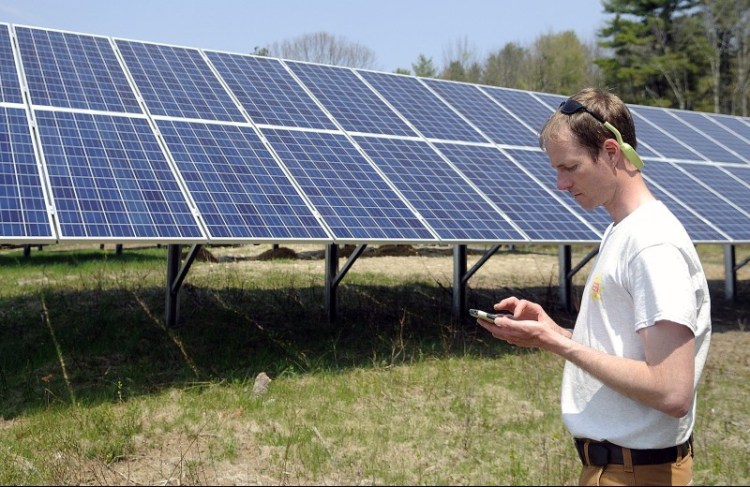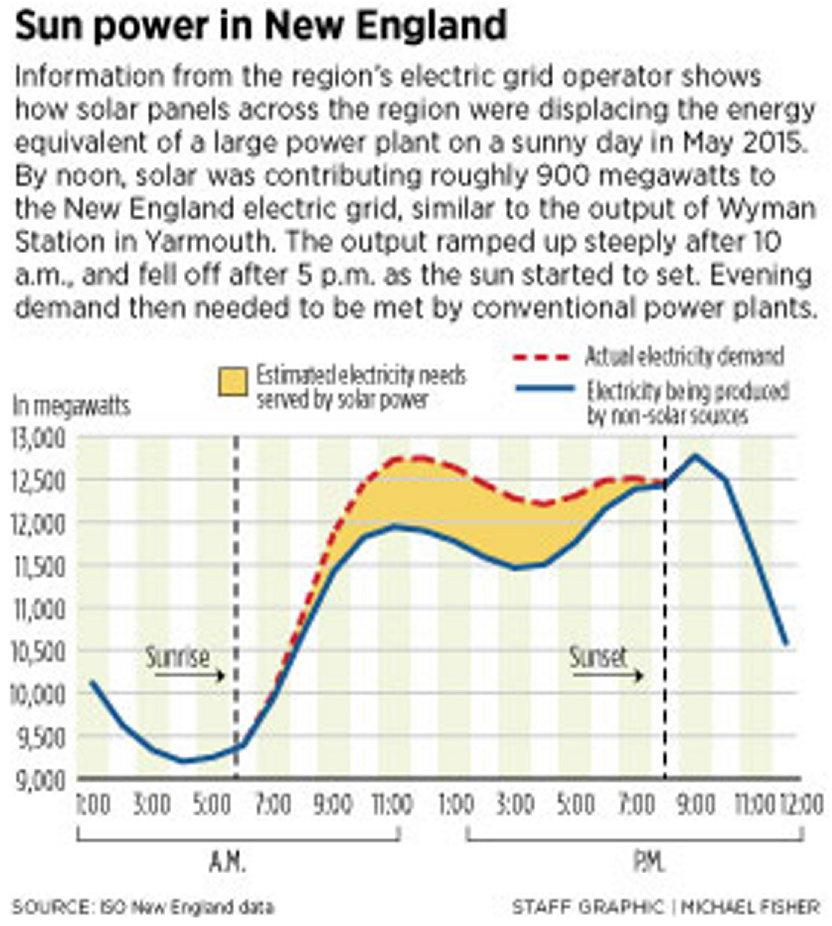Solar energy is expected to supply roughly 3 percent of New England’s power each year by 2025, and serve more than 20 percent of the demand during peak daytime periods in the spring and fall, according to the latest calculations by the region’s power grid operator.
Millions of solar modules, mostly on the roofs of homes and businesses, could trim the amount of power needed from conventional plants late on hot summer afternoons by 1,062 megawatts, ISO New England says. That’s the equivalent of some of the region’s larger generating stations. It’s nearly the capacity of the Seabrook nuclear plant in New Hampshire and more than the Wyman Station oil-fired plant in Yarmouth.
But lacking development incentives, Maine solar producers are not big players in this emerging landscape, even as state regulatory authorities examine how solar generators should be credited for their contributions to the grid.
Despite Maine’s minor contributions, this trend already has begun. ISO New England recently highlighted data from a sunny day in May of 2015, as an example, when the sun was displacing 900 megawatts of capacity that otherwise would have come from conventional power plants.
But as solar penetration grows, the ISO says, it will have the effect of pushing the period of peak demand later into the afternoon. That will create a problem because, as the sun sets and solar generation ebbs, power demand will remain high for a few more hours. To fill that gap, planners expect to turn on efficient, gas-fired power plants. They’re also creating financial incentives for factories to strategically turn off unneeded motors and lights. Future ideas include signaling electric water heaters to briefly shut down and tapping battery banks that store solar power during the day.
COMPLEX PICTURE OF SOLAR’S ROLE
The new solar reality poses a challenge to keep New England’s lights on.
Unlike natural gas flowing from a pipeline, sunshine can be variable. And unlike a large power plant directly connected to the grid, the millions of solar modules scattered from Maine to Connecticut can’t be seen or contacted by ISO control room operators.
“The biggest challenge is trying to understand how much power all those solar farms are producing,” said John Norden, director of operations at ISO New England. “Because I can’t see them, I don’t know how much conventional generation to bring on.”
To help make that call, Norden and his team are using sophisticated weather forecasts that calculate solar irradiance, a unit measure of power from the sun. It’s easier on a clear day, and trickier when the sun darts in and out of the clouds.
This new and complicated picture of solar’s role in the New England energy mix is emerging just as the Maine Public Utilities Commission is opening a case to review what’s commonly known as net metering, the rule by which utilities credit small customers who generate power and feed it into the grid.
The PUC inquiry will consider potential changes to the rate that customers now get for this power, whether existing customers should be “grandfathered” from any changes, and whether solar-electric panels should be treated differently than other eligible resources, such as small-scale hydroelectric dams.
The PUC hasn’t set a date by which it will decide the net metering case, but has asked that comments be filed by July 22.
In one early response, a group of 28 parties has asked the commission to conduct a narrow review that makes no changes to net energy billing, in order for lawmakers and solar advocates to take up the issue next year in the Legislature. The group includes several solar installers, small businesses and clean-energy advocates.
ISO New England doesn’t take a position on state energy policies, and the PUC process isn’t meant to address energy supply issues. But in various reports and studies underway, the grid operator is planning for solar to play an increasingly important role in the region’s energy mix. For that reason, its latest solar forecast adds some context to the ongoing political and social debate in Maine over net metering and the value of energy from the sun.
Democrats and clean-energy advocates say solar is a cost-effective alternative that diversifies Maine’s energy mix and contributes to economic growth. Their effort to pass a sweeping solar-energy development bill last spring was narrowly defeated by Gov. Paul LePage and Republican allies, who argued that the current net metering credits given to homeowners with solar panels are too high and a burden to other ratepayers.
These viewpoints are likely to resurface in the PUC proceeding, but they won’t change the overall solar trends in New England.
“The ISO is having to respond to aggressive solar policies in other New England states,” said Tim Schneider, Maine’s public advocate. “And that’s going to happen, regardless of what Maine does.”
The growth of solar in New England is being driven in large part by policies that promote renewable energy in Massachusetts and, to a lesser extent, Connecticut. Roughly 1,774 megawatts of solar currently are installed in the region and 1,241 megawatts of that are in Massachusetts. Connecticut trails with 273, and Vermont is third with 154. Maine has by far the least of the six states, at 20 megawatts.
In its 2016 PV (photovoltaic) forecast, ISO analysts use various assumptions to fine tune their projections. These include the impact of federal tax credits for solar installations, along with state incentives such as net metering. For Maine, the forecast accuracy was discounted because of “the high degree of uncertainty associated with possible future expansion of state policies and/or future market conditions required to support PV commercialization in the absence of policy expansion.”
“Other states are making big bets on renewables,” Schneider said. “Because we’re part of the regional grid, we’ll be going along for the ride.”
ADJUSTING FOR SOLAR’S VARIATIONS
The public advocate said the impact of solar’s growth on Maine utility rates is complex and evolving. To the extent that solar can displace expensive power plants at peak periods, that’s a good thing. But the cost of filling the gaps after sunset remains unclear.
One consideration is that New England has different solar potentials at different times of the year.
In the winter, when the sun sets early, solar can’t help meet peak demand because that period occurs after dark. But the ISO has determined that solar can reduce the need for natural gas to fuel power plants on sunny winter days between 11 a.m. and 2 p.m. Because solar has no fuel cost, it can help trim wholesale natural gas prices that drive up electric rates, said Norden, the ISO director. If clouds suddenly block the sun, however, operators need to ramp up quick-start power plants, at a time when gas supplies could be tight and expensive.
As solar penetration grows, clean-energy advocates will push for policies that encourage efficiency over new power plants to fill the gap.
“Solar can do a lot of the heavy lifting in terms of total energy production and lowering the daytime peak,” said Fortunat Mueller, co-founder of ReVision Energy in Portland. “That leaves the remaining work to do as something that is more manageable.”
Mueller, whose company is Maine’s largest solar installer, favors policies and market forces that will encourage short-term energy storage and shift demand to times when power is less expensive.
“It isn’t at all hard to ramp up batteries or turn off a bunch of water heaters for an hour or two,” he said.
Copy the Story Link
Send questions/comments to the editors.





Success. Please wait for the page to reload. If the page does not reload within 5 seconds, please refresh the page.
Enter your email and password to access comments.
Hi, to comment on stories you must . This profile is in addition to your subscription and website login.
Already have a commenting profile? .
Invalid username/password.
Please check your email to confirm and complete your registration.
Only subscribers are eligible to post comments. Please subscribe or login first for digital access. Here’s why.
Use the form below to reset your password. When you've submitted your account email, we will send an email with a reset code.